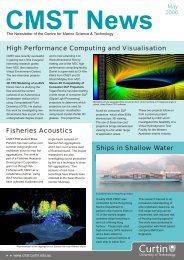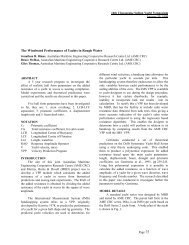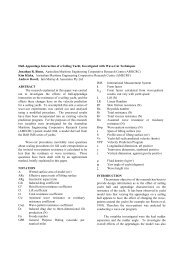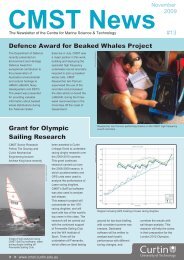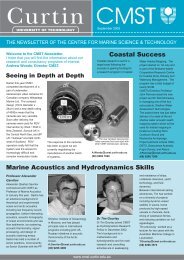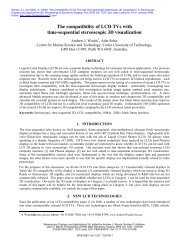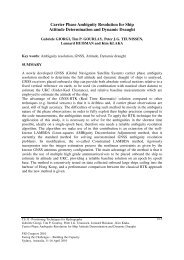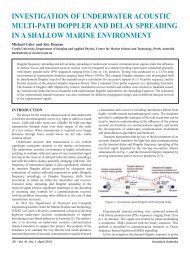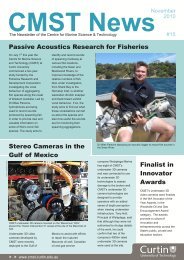Blue whale calling in the Rottnest trench-2000, Western ... - ANP
Blue whale calling in the Rottnest trench-2000, Western ... - ANP
Blue whale calling in the Rottnest trench-2000, Western ... - ANP
You also want an ePaper? Increase the reach of your titles
YUMPU automatically turns print PDFs into web optimized ePapers that Google loves.
Table 1: Details of record<strong>in</strong>gs made. Abbreviations or superscripts are: 1 - f<strong>in</strong>ish date given only for sets with<br />
repetitive sampl<strong>in</strong>g as opposed to a s<strong>in</strong>gle drift sample.<br />
Set # date<br />
start<br />
f<strong>in</strong>ish 1<br />
useable<br />
time start /<br />
stop<br />
# records /<br />
sample<br />
<strong>in</strong>crement<br />
type lat <strong>in</strong> long <strong>in</strong> hyd<br />
depth<br />
(m)<br />
8<br />
water<br />
depth at<br />
hyd (m)<br />
2456 10-Jan 09:20-10:58 1 drift 31 58.62 115 09.77 55 860<br />
2459 10-Jan 12:08 (first) 60 / 3 m<strong>in</strong> moored 31 58.49 115 15.07 45-60 160<br />
12-Jan 09:56 (last) every 44 m<strong>in</strong><br />
2460 13-Jan 09:56-13:15 1 drift 31 58.08 115 06.72 55 1000<br />
2461 18-Jan 09:17-13:26 1 drift 31 53.5 115 08.38 55 230<br />
2462 28-Jan 08:38-12:49 1 drift 32 01.49 115 09.85 55 430<br />
2463 29-Jan 09:21-13:25 1 drift 31 59.25 115 09.34 55 780<br />
2464 12-Feb 13:27-16:05 1 drift 31 56.55 115 17.25 55 125<br />
2465 14-Feb 08:26-11:55 1 drift 32 00.07 115 05.71 55 830<br />
2467 17-Feb 08:23-09:00 1 drift 32 01.07 115 05.08 55 790<br />
2468 27-Feb 09:12-12:38 1 drift 31 59.22 115 08.05 55 770<br />
2469 28-Feb 09:34-13:45 1 drift 31 59.85 115 08.40 55 660<br />
2466 8-Mar 00:10 8-Mar 4827 / 90 s moored 31 55.13 114 59.96 450 450<br />
10-Apr 12:30 10-Ap every 10 m<strong>in</strong><br />
2470 13-Mar 12:20-13:00 1 drift 31 59.96 115 5.06 55 920<br />
Sal<strong>in</strong>ity, temperature and depth profiles were taken opportunistically with a Marimatech HMS<br />
1820 CTD profiler with a nom<strong>in</strong>al maximum depth rat<strong>in</strong>g of 250 m, although it was used to 300<br />
m depth. The Leeuw<strong>in</strong> current was a consistent feature throughout January to April. CTD<br />
profiles showed a warm body of water at 21-22.5 o C from <strong>the</strong> surface down to between 70-200 m<br />
where a sharp <strong>the</strong>rmocl<strong>in</strong>e existed. Two examples are shown <strong>in</strong> Figure 4 from a site at <strong>the</strong> <strong>trench</strong><br />
head and <strong>the</strong> 'bluey' logger deployment site on <strong>the</strong> day of recovery. Water temperatures dropped<br />
steadily below <strong>the</strong> base of <strong>the</strong> Leeuw<strong>in</strong> current, with one record show<strong>in</strong>g 10 o C water at 300 m<br />
depth but most settl<strong>in</strong>g between 13-19 o C at 250-300 m depth. On <strong>the</strong> last sample taken on <strong>the</strong><br />
10-April at <strong>the</strong> bluey logger site (square Figure 1) <strong>the</strong> Leeuw<strong>in</strong> current extended to 200 m depth<br />
below which <strong>the</strong> temperature steadily dropped. All sound speed profiles showed a sound speed<br />
maximum at <strong>the</strong> base of <strong>the</strong> Leeuw<strong>in</strong> current of between 1530-1532 ms -1 .<br />
In <strong>the</strong> deeper waters of <strong>the</strong> <strong>trench</strong> it would be expected that cold-deep oceanic water would<br />
occur. Thus below <strong>the</strong> Leeuw<strong>in</strong> current, <strong>the</strong> temperature and sal<strong>in</strong>ity would be expected to<br />
steadily drop as observed, until <strong>the</strong> deep ocean temperature and sal<strong>in</strong>ity where met, <strong>the</strong>n rema<strong>in</strong><br />
relatively constant to <strong>the</strong> bottom. An idealised sound speed profile based on this scenario us<strong>in</strong>g<br />
<strong>the</strong> 200 m thick Leeuw<strong>in</strong> current profile shown <strong>in</strong> Figure 4-bottom and a sound speed structure<br />
below this depth as for <strong>the</strong> deep sea at <strong>the</strong> appropriate latitude (from Urick, 1983), is shown on<br />
Figure 5.



